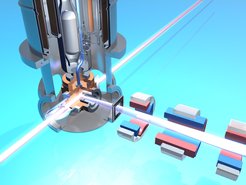Matter-antimatter symmetry confirmed with precision record
CERN experiment sets precision record in the measurement of the antiproton to electron mass ratio using a new innovative cooling technique
According to the Standard Model of elementary particle physics, to each particle exists an antiparticle that is supposed to behave exactly the same way. Thus, “anti-people” in an “anti-world” would observe the same laws of physics, or make the same experiences in general, as we do. This postulate is, however, difficult to prove, since it is almost impossible to perform measurements on antimatter: whenever an antiparticle meets is matter-counterpart, both particles annihilate, accompanied by the creation of energy. However, a team of scientists from the Max Planck Institute of Quantum Optics and Tokyo University (Japan), and including the University of Brescia (Italy), and the Wigner Research Centre for Physics (Budapest, Hungary), has found a way to overcome this hurdle: In an experiment carried out at the European Laboratory for Particle Physics (CERN) in Geneva (Switzerland) they trap an antiproton inside a helium atom. As due to a new cooling technique the helium atoms are almost at rest, high precision spectroscopy measurements are made possible. “For the mass of the antiproton relative to the electron we have achieved the unprecedented accuracy of 800 parts per trillion,” says Dr. Masaki Hori, leader of the research group “Antimatter Spectroscopy” which is associated with the Laser Spectroscopy Division of Prof. Theodor W. Hänsch at MPQ. (Science, 4 November, 2016).
In 1997, researchers from the Max Planck Institute of Quantum Optics in cooperation with other European, Japanese, and American groups began construction of a facility called the Antiproton Decelerator (AD) at CERN. Here antiprotons produced in high-energy collisions are collected and stored in a vacuum pipe arranged in a 190-m-long racetrack shape. The antiprotons are gradually slowed down, before being transported to several experiments. The so-called ASACUSA (Atomic Spectroscopy and Collisions using Slow Antiprotons, named after a district in Tokyo) collaboration, of which Dr. Hori is one of the project leaders, sends the antiprotons into a helium gas target. Normal helium atoms consist of a nucleus with two electrons orbiting around it. When the antiprotons hit the helium atoms, about 3% of the antiparticles replace one of the electrons, resulting in antiprotonic helium. The antiproton finds itself in an excited orbit some 100 picometres (10-10 m) from the nucleus. In order to determine its mass the scientists perform precision spectroscopy: they fire a laser beam onto the atom, and carefully tune its frequency until the antiproton makes a quantum jump from one energy orbit to another. By comparing this frequency with theoretical calculations, the mass of the antiproton can be determined relative to the electron.

However, an important source of imprecision remained so far, because the antiprotonic atoms move around randomly according to their thermal energy, so that atoms moving towards the laser beam experience a different frequency compared to those moving away. The new major achievement of the collaboration as reported in Science, lies in the fact that ASACUSA now managed to cool down the antiprotonic helium atoms to temperatures close to absolute zero - between 1.5 and 1.7 Kelvin. “We cooled down the atoms using buffer-gas cooling,” explains Dr. Hori. “It is surprising that this method works at all, because normally – if you use normal matter atoms to cool a half-antimatter atom – you would expect that the atom would annihilate instead of cooling down. But here annihilation is prevented because the antiproton is safely shielded by the electron.” The new measurements, based on data collected from 2010 to 2014, with about 2 billion atoms, showed that the antiproton is 1836.1526734(15) times heavier than the electron, the parenthesis showing the 1-standard deviation imprecision. This is in excellent agreement with a recent experimental value for the proton-to-electron mass ratio.
Physicists believe that the laws of nature obey a fundamental symmetry called “CPT” (this stands for charge conjugation, parity, and time reversal), which postulates that if all the matter in the universe were replaced with antimatter, left and right inverted as if looking into a mirror, and the flow of time reversed, this “anti-world” would be indistinguishable from our real matter world. If scientists were to experimentally detect any deviation, however small, it would indicate that this fundamental symmetry is broken. And this could possibly lead to an explanation of why the universe we live in is made entirely of matter, whereas at the beginning of the universe, in the “big bang”, matter and antimatter was created in the same amount. “We are confident that we will be able to even improve this precision by combining buffer-gas cooling with two-photon spectroscopy, a method that by itself reduces uncertainties caused by the Doppler-effect”, resumes Masaki Hori. To this end, a new experiment at CERN named ELENA is planned. Olivia Meyer-Streng












